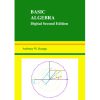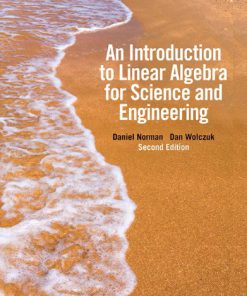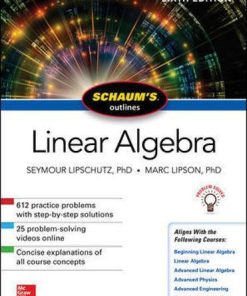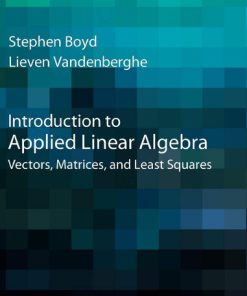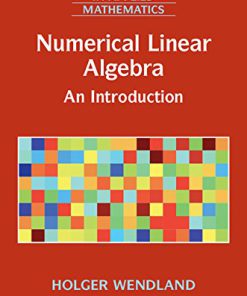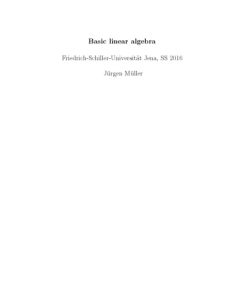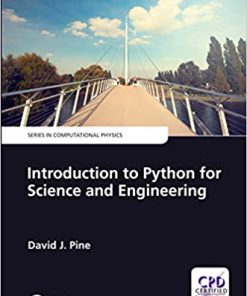Introduction to Linear Algebra for Science and Engineering 3rd Edition by Daniel Norman, Dan Wolczuk ISBN 9780134682631 0134682637
$50.00 Original price was: $50.00.$25.00Current price is: $25.00.
Introduction to Linear Algebra for Science and Engineering 3rd Edition by Daniel Norman, Dan Wolczuk – Ebook PDF Instant Download/Delivery: 9780134682631, 0134682637
Full download Introduction to Linear Algebra for Science and Engineering 3rd Edition after payment
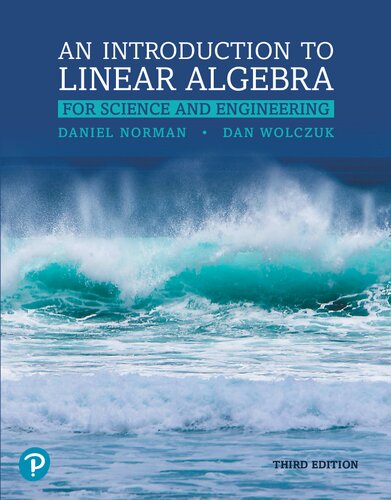
Product details:
ISBN 10: 0134682637
ISBN 13: 9780134682631
Author: Daniel Norman, Dan Wolczuk
Note: You are purchasing a standalone product; MyLab Mathematics does not come packaged with this content. Students, if interested in purchasing this title with MyLab Mathematics, ask your instructor for the correct package ISBN and Course ID. Instructors, contact your Pearson representative for more information.
Norman/Wolczuk’s An Introduction to Linear Algebra for Science and Engineering has been widely respected for its unique approach, which helps students understand and apply theory and concepts by combining theory with computations and slowly bringing students to the difficult abstract concepts. This approach includes an early treatment of vector spaces and complex topics in a simpler, geometric context. An Introduction to Linear Algebra for Science and Engineering promotes advanced thinking and understanding by encouraging students to make connections between previously learned and new concepts and demonstrates the importance of each topic through applications.
Table of contents:
Chapter 1: Euclidean Vector Spaces
1.1. Vectors in R2 and R3
1.2. Spanning and Linear Independence in R2 and R3
1.3. Length and Angles in R2 and R3
1.4. Vectors in Rn
1.5. Dot Products and Projections in Rn
Chapter Review
Chapter 2: Systems of Linear Equations
2.1. Systems of Linear Equations and Elimination
2.2. Reduced Row Echelon Form, Rank, and Homogeneous Systems
2.3. Application to Spanning and Linear Independence
2.4. Applications of Systems of Linear Equations
Chapter Review
Chapter 3: Matrices, LinearMappings, and Inverses
3.1. Operations onMatrices
3.2. MatrixMappings and LinearMappings
3.3. Geometrical Transformations
3.4. Special Subspaces
3.5. InverseMatrices and InverseMappings
3.6. ElementaryMatrices
3.7. LU-Decomposition
Chapter Review
Chapter 4: Vector Spaces
4.1. Spaces of Polynomials
4.2. Vector Spaces
4.3. Bases and Dimensions
4.4. Coordinates
4.5. General LinearMappings
4.6. Matrix of a LinearMapping
4.7. Isomorphisms of Vector Spaces
Chapter Review
Chapter 5: Determinants
5.1. Determinants in Terms of Cofactors
5.2. Properties of the Determinant
5.3. Inverse by Cofactors, Cramer’s Rule
5.4. Area, Volume, and the Determinant
Chapter Review
Chapter 6: Eigenvectors and Diagonalization
6.1. Eigenvalues and Eigenvectors
6.2. Diagonalization
6.3. Applications of Diagonalization
Chapter Review
Chapter 7: Inner Products and Projections
7.1. Orthogonal Bases in Rn
7.2. Projections and the Gram-Schmidt Procedure
7.3. Method of Least Squares
7.4. Inner Product Spaces
7.5. Fourier Series
Chapter Review
Chapter 8: SymmetricMatrices and Quadratic Forms
8.1. Diagonalization of SymmetricMatrices
8.2. Quadratic Forms
8.3. Graphs of Quadratic Forms
8.4. Applications of Quadratic Forms
8.5. Singular Value Decomposition
Chapter Review
Chapter 9: Complex Vector Spaces
9.1. Complex Numbers
9.2. Systems with Complex Numbers
9.3. Complex Vector Spaces
9.4. Complex Diagonalization
9.5. Unitary Diagonalization
People also search for:
an introduction to linear algebra for science and engineering solutions
an introduction to linear algebra for science and engineering answers
introduction to linear algebra for science and engineering 3rd ed
introduction to linear algebra for science and engineering solution manual
introduction to linear algebra for science and engineering 2nd edition
Tags: Daniel Norman, Dan Wolczuk, Introduction, Linear Algebra, Science, Engineering
You may also like…
Mathematics - Applied Mathematics
Numerical Linear Algebra A Concise Introduction with MATLAB and Julia Folkmar Bornemann
Mathematics
Introduction to Applied Linear Algebra Vectors Matrices and Least Squares 1st Edition Stephen Boyd
Uncategorized
Computers - Programming
Introduction to Python for Science and Engineering 1st Edition David J. Pine
Mathematics
SF1624 Algebra and Geometry Introduction to Linear Algebra for Science Engineering Daniel Norman


